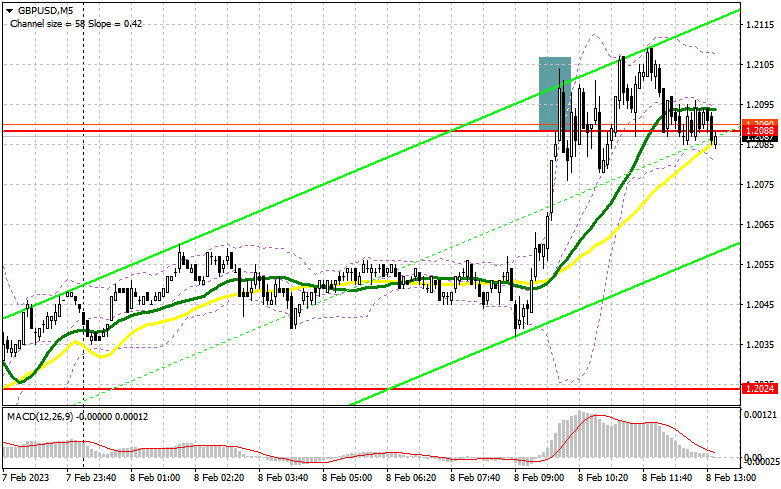
Long positions on GBP/USD:
In my previous forecast, I drew your attention to the level of 1.2090 and recommended entering the market from it. Let's have a look at the 5-minute chart and analyze the situation. The British pound jumped but failed to pierce 1.2012. This created a sell signal. However, the pair did not decline sharply. As a result, at the beginning of the North American session, I decided to move my short positions to the breakeven point and reconsider the technical picture.

US policymakers' comments may return pressure on GBP. It is clear that FOMC members John Williams, Michael Barr, and Christopher Waller, speaking today, are highly likely to support the Federal Reserve Chairman's decision to raise interest rates, so we will not hear anything new from them. This fact will support bulls. If the GBP/USD pair goes down on the US data, it would be better to buy GBP near the new support of 1.2041, where the moving averages are passing. Notably, the MAs are on the side of bulls. A false breakout at this level may confirm that big buyers are in the market and give a good entry point near the new resistance of 1.2141, which was formed last week. If the price settles above this level and tests this level from above, we can expect the GBP/USD pair to move upwards sharply to the high of 1.2191, where traders may book their profit. If bulls fail to protect 1.2041, the development of the bear market will continue. For this reason, it would be better to postpone opening long positions. One may open long positions after a decline and a false breakout near the next support at 1.1964. You can also buy GBP on a rebound from 1.1881, allowing an intraday correction of 30-35 pips.
Short positions on GBP/USD:
Bears tried to push the price lower but failed. However, it does not mean that bulls are dominating the market. It confirms that nobody wants to sell GBP now. If the statements of the Fed representatives will be more convincing than expected, the pressure on the pound sterling is likely to increase. As for now, it is better to open short positions only near the new resistance of 1.2141. Notably, the pair is about to reach this level. A false breakout at this level will be enough to get a sell signal with the target at the new support of 1.2041, formed in the first half of the day, where the moving averages are located. The MAs are supporting bulls now. A breakthrough and a downward test of this level may reinforce bears' positions in the market, creating a sell signal with the fall to 1.9164. If the price tests this level, the downtrend may continue. The next target is located at 1.1881 but the price is unlikely to reach it today. If the GBP/USD pair grows and we see weak activity from bears at 1.2141, bulls will take control of the market. In that case, only a false breakout near 1.2191 may create an entry point into short positions. If we see no activity at this level, it would be better to sell GBP from the high of 1.2239, counting on an intraday downward rebound of 30-35 pips.

COT report
The COT report from January 24 logged a sharp drop in long and short positions. However, the current decline was quite acceptable. The fact is that the UK government is coming across tough times. It is struggling with strikes and demands to raise wages and at the same time, it is trying to achieve a steady decline in inflation. However, this is of less importance at the moment since traders are waiting for the meetings of the Fed and the BoE. The Fed is expected to switch to a less hawkish stance, whereas the BoE may remain aggressive, refraining from increasing the interest rate by 0.50%. This may have a positive effect on the pound sterling. That is why I will bet on its further rise. The recent COT report showed that the number of short non-commercial positions decreased by 7,476 to 58,690, while the number of long non-commercial positions decreased by 6,713 to 34,756. As a result, the negative value of the non-commercial net position dropped to -23,934 from -24,697 a week earlier. Such minor changes will hardly affect the market situation. Thus, we will continue to closely monitor the economic indicators for the UK and the decision of the Bank of England. The weekly closing price rose to 1.2350 against 1.2290.
Signals of indicators:
Moving averages
Trading is carried out slightly above 30- and 50-day moving averages, which points to uncertainty in the market.
Note: The author considers the period and prices of moving averages on the one-hour chart which differ from the general definition of the classic daily moving averages on the daily chart.
Bollinger Bands
If the pair increases, the upper band of the indicator at 1.2100 will offer resistance.
Description of indicators
Moving average determines the current trend by smoothing volatility and noise. Period 50. Marked in yellow on the chart.Moving average determines the current trend by smoothing volatility and noise. Period 30. Marked in green on the chart.MACD indicator (Moving Average Convergence/Divergence). Fast EMA 12. Slow EMA 26. SMA 9.Bollinger Bands. Period 20.Non-profit speculative traders are individual traders, hedge funds, and large institutions that use the futures market for speculative purposes and meet certain requirements.Long non-commercial positions are the total number of long positions opened by non-commercial traders.Short non-commercial positions are the total number of short positions opened by non-commercial traders.Total non-commercial net position is a difference in the number of short and long positions opened by non-commercial traders.